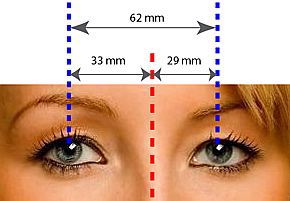


You need your PD measurement for that.ĭon’t worry. An optician typically will measure your PDs with a high-precision measuring device called a pupillometer.īut let’s say you have your eyeglass prescription and want to buy a stylish pair of eyeglasses online. The range for children is approximately 41-55mm. Pupillary distance measurements usually are taken when you are being fitted for glasses after your eye exam. Average pupillary distance for an adult is between 54-68mm, with acceptable measurement deviations generally falling in between 48mm and 73mm.
PUPIL DISTANCE ON GLASSES HOW TO
Read below to learn how to calculate near PD for reading glasses. Distance PD can be used to order any type of prescription glasses except reading glasses. But the sum of your two monocular PD measurements should always equal your binocular pupillary distance. SINGLE PD is the pupillary distance between the center of one pupil to the other, which can be a distance PD or near PD. This is the distance between the center of the pupil of one eye and the center of the pupil of the other eye.ĭue to facial asymmetry, monocular PDs aren’t always exactly the same. Monocular PDs are required for accurate fitting of progressive lenses.īinocular PD. This is the distance between the center of your pupil and the middle of the bridge of your nose. There are two types of pupillary distance measurements: The average pupillary distance for an adult is about 63 mm, but this is not a number you’ll want to assume. Pupillary distance can vary widely - roughly between 51 mm and 74.5 mm for women and 53 mm and 77 mm for men. For greatest comfort and clarity, the optical center of each lens of your glasses should be aligned directly in front of the center of your pupil. It is an essential measurement when buying a new pair of eyeglasses or prescription sunglasses. The mm line that lines up to the center of your right pupil is your PD.Pupillary distance (PD) is the distance between the pupils of your two eyes.Close your left eye and open your right eye.If your frames do not have any lenses in them at all (prescription lenses, demonstration or dummy. PD (Pupillary Distance) PD is the distance measured in millimeters (mm) between the centers of each pupil, and is used to make prescription eyeglasses. Align the ruler’s 0 mm with the center of your left pupil. Dot the pupil center on each lens with a permanent marker.In order for our glasses to perform at their best,we use. Well-fitting glasses will create a sense of visual balance. average pupillary distance is 64mm for men and 62mm for women.

Measuring your PD at home for new glasses wearers Your pupillary distance (PD) is the distance in millimeters between the centers of your pupils. For lower prescriptions, we can make your glasses with an average pupillary distance.

With a ruler measure the distance between the two dots.Close your right eye and, with a non-permanent marker pen, mark the center of the left pupil on the lens.Wearing your current glasses, stand in front of a mirror and look straight into it.Measuring your PD at home for glasses wearers Your PD or Pupillary Distance Measurement is the distance in millimeters between your pupils, typically when your eyes are focused at a distance of 20 feet or. Use one of the step-by-step guides below to measure your PD at home.After completing your online order, send us a picture of your face with a bank card on your forehead and we’ll work it out for you.These measurements aren’t always the most accurate, we advise you to try a few different ones to get the correct PD measurement. Use one of many online tools to work out your PD measurements.Your PD measurement is normally included in your prescription from your optician, if not you can:


 0 kommentar(er)
0 kommentar(er)
